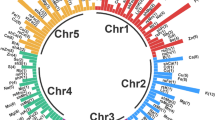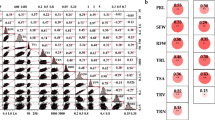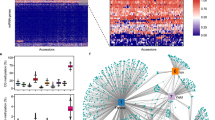Abstract
Key message
This study provided important insights into the genetic architecture of variations in A. thaliana leaf ionome in a cell-type-specific manner.
Abstract
The functional interpretation of traits associated variants by expression quantitative trait loci (eQTL) analysis is usually performed in bulk tissue samples. While the regulation of gene expression is context-dependent, such as cell-type-specific manner. In this study, we estimated cell-type abundances from 728 bulk tissue samples using single-cell RNA-sequencing dataset, and performed cis-eQTL mapping to identify cell-type-interaction eQTL (cis-eQTLs(ci)) in A. thaliana. Also, we performed Genome-wide association studies (GWAS) analyses for 999 accessions to identify the genetic basis of variations in A. thaliana leaf ionome. As a result, a total of 5,664 unique eQTL genes and 15,038 unique cis-eQTLs(ci) were significant. The majority (62.83%) of cis-eQTLs(ci) were cell-type-specific eQTLs. Using colocalization, we uncovered one interested gene AT2G25590 in Phloem cell, encoding a kind of plant Tudor-like protein with possible chromatin-associated functions, which colocalized with the most significant cis-eQTL(ci) of a Mo-related locus (Chr2:10,908,806:A:C; P = 3.27 × 10–27). Furthermore, we prioritized eight target genes associated with AT2G25590, which were previously reported in regulating the concentration of Mo element in A. thaliana. This study revealed the genetic regulation of ionomic variations and provided a foundation for further studies on molecular mechanisms of genetic variants controlling the A. thaliana ionome.





Similar content being viewed by others
Data availability
We provide the R script needed to reproduce the processed scRNA-seq datasets results of ct-eQTL, and as for supplementary tables, please visit the database linking page (https://github.com/Jasonxu0109/ct-eQTL).
References
Baxter I, Muthukumar B, Park HC et al (2008) Variation in molybdenum content across broadly distributed populations of Arabidopsis thaliana is controlled by a mitochondrial molybdenum transporter (MOT1). PLoS Gene. https://doi.org/10.1371/journal.pgen.1000004
Boutet E, Lieberherr D, Tognolli M et al (2016) UniProtKB/Swiss-Prot, the manually annotated section of the UniProt KnowledgeBase: How to use the entry view. Methods in Molecular Biology (clifton, NJ) 1374:23–54. https://doi.org/10.1007/978-1-4939-3167-5_2
Bray NL, Pimentel H, Melsted P, Pachter L (2016) Near-optimal probabilistic RNA-seq quantification. Nat Biotechnol 34:525–527. https://doi.org/10.1038/nbt.3519
Buniello A, MacArthur JAL, Cerezo M et al (2019) The NHGRI-EBI GWAS Catalog of published genome-wide association studies, targeted arrays and summary statistics 2019. Nucleic Acids Res 47:D1005–D1012. https://doi.org/10.1093/nar/gky1120
Campos ACAL, van Dijk WFA, Ramakrishna P et al (2021) 1,135 ionomes reveal the global pattern of leaf and seed mineral nutrient and trace element diversity in Arabidopsis thaliana. Plant J 106:536–554. https://doi.org/10.1111/tpj.15177
Chen H, Yin X, Guo L et al (2021) PlantscRNAdb: A database for plant single-cell RNA analysis. Mol Plant 14:855–857. https://doi.org/10.1016/j.molp.2021.05.002
Choudhary S (2019) pysradb: A Python package to query next-generation sequencing metadata and data from NCBI Sequence Read Archive. F1000Research 10.12688/f1000research.18676.1
Danecek P, Bonfield JK, Liddle J, et al (2021) Twelve years of SAMtools and BCFtools. GigaScience 10:giab008. https://doi.org/10.1093/gigascience/giab008
Dobbyn A, Huckins LM, Boocock J et al (2018) Landscape of conditional eQTL in dorsolateral prefrontal cortex and co-localization with schizophrenia GWAS. Am J Hum Genet 102:1169–1184. https://doi.org/10.1016/j.ajhg.2018.04.011
Ernst J, Kellis M (2012) ChromHMM: Automating chromatin-state discovery and characterization. Nat Methods 9:215–216. https://doi.org/10.1038/nmeth.1906
Feng J, Liu T, Qin B et al (2012) Identifying ChIP-seq enrichment using MACS. Nat Protoc 7:1728–1740. https://doi.org/10.1038/nprot.2012.101
Flint-Garcia SA, Thornsberry JM, Buckler ES (2003) Structure of linkage disequilibrium in plants. Annu Rev Plant Biol 54:357–374. https://doi.org/10.1146/annurev.arplant.54.031902.134907
Giambartolomei C, Vukcevic D, Schadt EE et al (2014) Bayesian test for colocalisation between pairs of genetic association studies using summary statistics. PLoS Genet. https://doi.org/10.1371/journal.pgen.1004383
Giral H, Landmesser U, Kratzer A (2018) Into the wild: GWAS exploration of non-coding RNAs. Frontiers Cardiovascular Med 5:181. https://doi.org/10.3389/fcvm.2018.00181
Gong J, Mei S, Liu C et al (2018) PancanQTL: Systematic identification of cis-eQTLs and trans-eQTLs in 33 cancer types. Nucleic Acids Res 46:D971–D976. https://doi.org/10.1093/nar/gkx861
Graffelman J (2015) Exploring diallelic genetic markers: The HardyWeinberg package. J Stat Softw. https://doi.org/10.1837/jss.v064.i03
GTEx Consortium (2015) Human genomics. the genotype-tissue expression (GTEx) pilot analysis: Multitissue gene regulation in humans. Science (new York, NY) 348:648–660. https://doi.org/10.1126/science.1262110
Hao Y, Hao S, Andersen-Nissen E et al (2021) Integrated analysis of multimodal single-cell data. Cell 184:3573-3587.e29. https://doi.org/10.1016/j.cell.2021.04.048
Huang X, Han B (2014) Natural variations and genome-wide association studies in crop plants. Annu Rev Plant Biol 65:531–551. https://doi.org/10.1146/annurev-arplant-050213-035715
Ide Y, Kusano M, Oikawa A et al (2011) Effects of molybdenum deficiency and defects in molybdate transporter MOT1 on transcript accumulation and nitrogen/sulphur metabolism in Arabidopsis thaliana. J Exp Bot 62:1483–1497. https://doi.org/10.1093/jxb/erq345
Jiang X, O’Reilly PF, Aschard H et al (2018) Genome-wide association study in 79,366 European-ancestry individuals informs the genetic architecture of 25-hydroxyvitamin D levels. Nat Commun 9:260. https://doi.org/10.1038/s41467-017-02662-2
Kim J-Y, Symeonidi E, Pang TY et al (2021) Distinct identities of leaf phloem cells revealed by single cell transcriptomics. Plant Cell 33:511–530. https://doi.org/10.1093/plcell/koaa060
Kim-Hellmuth S, Aguet F, Oliva M, et al (2020) Cell type-specific genetic regulation of gene expression across human tissues. Science (New York, NY) 369:eaaz8528. https://doi.org/10.1126/science.aaz8528
Korte A, Farlow A (2013) The advantages and limitations of trait analysis with GWAS: A review. Plant Methods 9:29. https://doi.org/10.1186/1746-4811-9-29
Lachowiec J, Shen X, Queitsch C, Carlborg Ö (2015) A Genome-wide association analysis reveals epistatic cancellation of additive genetic variance for root length in Arabidopsis thaliana. PLoS Genet. https://doi.org/10.1371/journal.pgen.1005541
Lan Y, Sun R, Ouyang J et al (2021) AtMAD: Arabidopsis thaliana multi-omics association database. Nucleic Acids Res 49:D1445–D1451. https://doi.org/10.1093/nar/gkaa1042
Lanquar V, Ramos MS, Lelièvre F et al (2010) Export of vacuolar manganese by AtNRAMP3 and AtNRAMP4 is required for optimal photosynthesis and growth under manganese deficiency. Plant Physiol 152:1986–1999. https://doi.org/10.1104/pp.109.150946
Laurie C, Wang S, Carlini-Garcia LA, Zeng Z-B (2014) Mapping epistatic quantitative trait loci. BMC Genet 15:112. https://doi.org/10.1186/s12863-014-0112-9
Li H, Durbin R (2010) Fast and accurate long-read alignment with burrows-wheeler transform. Bioinformatics (oxford, England) 26:589–595. https://doi.org/10.1093/bioinformatics/btp698
Liang Y, Liu H-J, Yan J, Tian F (2021) Natural variation in crops: realized understanding, continuing promise. Annu Rev Plant Biol 72:357–385. https://doi.org/10.1146/annurev-arplant-080720-090632
Lim YW, Chen-Harris H, Mayba O et al (2018) Germline genetic polymorphisms influence tumor gene expression and immune cell infiltration. Proc Natl Acad Sci U S A 115:E11701–E11710. https://doi.org/10.1073/pnas.1804506115
Liu Y, Tian T, Zhang K et al (2018) PCSD: A plant chromatin state database. Nucleic Acids Res 46:D1157–D1167. https://doi.org/10.1093/nar/gkx919
Lu Z, Marand AP, Ricci WA et al (2019) The prevalence, evolution and chromatin signatures of plant regulatory elements. Nat Plants 5:1250–1259. https://doi.org/10.1038/s41477-019-0548-z
Mu Z, Wei W, Fair B et al (2021) The impact of cell type and context-dependent regulatory variants on human immune traits. Genome Biol 22:122. https://doi.org/10.1186/s13059-021-02334-x
NCBI Resource Coordinators (2018) Database resources of the National Center for Biotechnology Information. Nucleic Acids Res 46:D8–D13. https://doi.org/10.1093/nar/gkx1095
Nicolae DL, Gamazon E, Zhang W et al (2010) Trait-associated SNPs are more likely to be eQTLs: Annotation to enhance discovery from GWAS. PLoS Genet. https://doi.org/10.1371/journal.pgen.1000888
Nijveen H, Ligterink W, Keurentjes JJB et al (2017) AraQTL - workbench and archive for systems genetics in Arabidopsis thaliana. Plant J Cell Molecular Bio 89:1225–1235. https://doi.org/10.1111/tpj.13457
Pek JW, Anand A, Kai T (2012) Tudor domain proteins in Development. Development 139:2255–2266. https://doi.org/10.1242/dev.073304
Purcell S, Neale B, Todd-Brown K et al (2007) PLINK: A tool set for whole-genome association and population-based linkage analyses. Am J Hum Genet 81:559–575. https://doi.org/10.1086/519795
Quinlan AR, Hall IM (2010) BEDTools: A flexible suite of utilities for comparing genomic features. Bioinformatics (oxford, England) 26:841–842. https://doi.org/10.1093/bioinformatics/btq033
Rodgers-Melnick E, Vera DL, Bass HW, Buckler ES (2016) Open chromatin reveals the functional maize genome. Proc Natl Acad Sci U S A 113:E3177–E3184. https://doi.org/10.1073/pnas.1525244113
Shabalin AA (2012) Matrix eQTL: Ultra fast eQTL analysis via large matrix operations. Bioinformatics 28:1353–1358. https://doi.org/10.1093/bioinformatics/bts163
Sheng X, Guan Y, Ma Z et al (2021) Mapping the genetic architecture of human traits to cell types in the kidney identifies mechanisms of disease and potential treatments. Nat Genet 53:1322–1333. https://doi.org/10.1038/s41588-021-00909-9
Shi H, Lee B, Wu S-J, Zhu J-K (2003) Overexpression of a plasma membrane Na+/H+ antiporter gene improves salt tolerance in Arabidopsis thaliana. Nat Biotechnol 21:81–85. https://doi.org/10.1038/nbt766
Sijacic P, Bajic M, McKinney EC et al (2018) Chromatin accessibility changes between Arabidopsis stem cells and mesophyll cells illuminate cell type-specific transcription factor networks. Plant J Cell Molecular Bio 94:215–231. https://doi.org/10.1111/tpj.13882
Soneson C, Love MI, Robinson MD (2016) Differential analyses for RNA-seq: Transcript-level estimates improve gene-level inferences. F1000Research https://doi.org/10.12688/f1000research.7563.2
Steen CB, Liu CL, Alizadeh AA, Newman AM (2020) Profiling cell type abundance and expression in bulk tissues with CIBERSORTx. Methods Molecular Bio (clifton, NJ) 2117:135–157. https://doi.org/10.1007/978-1-0716-0301-7_7
Stegle O, Parts L, Piipari M et al (2012) Using probabilistic estimation of expression residuals (PEER) to obtain increased power and interpretability of gene expression analyses. Nat Protoc 7:500–507. https://doi.org/10.1038/nprot.2011.457
Tarasov A, Vilella AJ, Cuppen E et al (2015) Sambamba: Fast processing of NGS alignment formats. Bioinformatics (oxford, England) 31:2032–2034. https://doi.org/10.1093/bioinformatics/btv098
Togninalli M, Seren Ü, Meng D et al (2018) The AraGWAS Catalog: a curated and standardized Arabidopsis thaliana GWAS catalog. Nucleic Acids Res 46:D1150–D1156. https://doi.org/10.1093/nar/gkx954
Togninalli M, Seren Ü, Freudenthal JA et al (2020) AraPheno and the AraGWAS Catalog 2020: A major database update including RNA-Seq and knockout mutation data for Arabidopsis thaliana. Nucleic Acids Res 48:D1063–D1068. https://doi.org/10.1093/nar/gkz925
Tomatsu H, Takano J, Takahashi H et al (2007) An Arabidopsis thaliana high-affinity molybdate transporter required for efficient uptake of molybdate from soil. Proc Natl Acad Sci U S A 104:18807–18812. https://doi.org/10.1073/pnas.0706373104
Torgeman S, Zamir D (2023) Epistatic QTLs for yield heterosis in tomato. Proceedings National Academy Sci. https://doi.org/10.1073/pnas.2205787119
Tucker G, Price AL, Berger B (2014) Improving the power of GWAS and avoiding confounding from population stratification with PC-select. Genetics 197:1045–1049. https://doi.org/10.1534/genetics.114.164285
Uffelmann E, Huang QQ, Munung NS et al (2021) Genome-wide association studies. Nature Rev Methods Primers 1:1–21. https://doi.org/10.1038/s43586-021-00056-9
Wang J, Yu H, Xie W et al (2010) A global analysis of QTLs for expression variations in rice shoots at the early seedling stage. Plant J 63:1063–1074. https://doi.org/10.1111/j.1365-313X.2010.04303.x
Wang X, Park J, Susztak K et al (2019) Bulk tissue cell type deconvolution with multi-subject single-cell expression reference. Nat Commun 10:380. https://doi.org/10.1038/s41467-018-08023-x
Wang C, Sun D, Huang X et al (2020a) Integrative analyses of single-cell transcriptome and regulome using MAESTRO. Genome Biol 21:198. https://doi.org/10.1186/s13059-020-02116-x
Wang L, Zhang W, Li Q (2020b) AssocTests: An R package for genetic association studies. J Stat Softw. https://doi.org/10.18637/jss.v094.i05
Wang Q, Tang J, Han B, Huang X (2020c) Advances in genome-wide association studies of complex traits in rice. TAG Theoretical Applied Genetics Theoretische Und Angewandte Genetik 133:1415–1425. https://doi.org/10.1007/s00122-019-03473-3
Wang X, Ren M, Liu D et al (2020d) Large-scale identification of expression quantitative trait loci in Arabidopsis reveals novel candidate regulators of immune responses and other processes. J Integr Plant Biol 62:1469–1484. https://doi.org/10.1111/jipb.12930
Watanabe K, Taskesen E, van Bochoven A, Posthuma D (2017) Functional mapping and annotation of genetic associations with FUMA. Nat Commun 8:1826. https://doi.org/10.1038/s41467-017-01261-5
Whitt L, Ricachenevsky FK, Ziegler GZ et al (2020) A curated list of genes that affect the plant ionome. Plant Direct. https://doi.org/10.1002/pld3.272
Xu Y, Gan E-S, Zhou J et al (2014) Arabidopsis MRG domain proteins bridge two histone modifications to elevate expression of flowering genes. Nucleic Acids Res 42:10960–10974. https://doi.org/10.1093/nar/gku781
Xu W, Dai W, Yan H et al (2015) Arabidopsis NIP3;1 plays an important role in arsenic uptake and root-to-shoot translocation under arsenite stress conditions. Mol Plant 8:722–733. https://doi.org/10.1016/j.molp.2015.01.005
Yang M, Lu K, Zhao F-J et al (2018) Genome-wide association studies reveal the genetic basis of Ionomic variation in rice. Plant Cell 30:2720–2740. https://doi.org/10.1105/tpc.18.00375
Yazar S, Alquicira-Hernandez J, Wing K, et al (2022) Single-cell eQTL mapping identifies cell type-specific genetic control of autoimmune disease. Science (New York, NY) 376:eabf3041. https://doi.org/10.1126/science.abf3041
Zhang L, Yu Y, Shi T et al (2020) Genome-wide analysis of expression quantitative trait loci (eQTLs) reveals the regulatory architecture of gene expression variation in the storage roots of sweet potato. Horticulture Research 7:1–12. https://doi.org/10.1038/s41438-020-0314-4
Zhao H, Tu Z, Liu Y et al (2021) PlantDeepSEA, a deep learning-based web service to predict the regulatory effects of genomic variants in plants. Nucleic Acids Res 49:W523–W529. https://doi.org/10.1093/nar/gkab383
Zhou J, Troyanskaya OG (2015) Predicting effects of noncoding variants with deep learning-based sequence model. Nat Methods 12:931–934. https://doi.org/10.1038/nmeth.3547
Zmienko A, Marszalek-Zenczak M, Wojciechowski P et al (2020) AthCNV: A map of DNA copy number variations in the Arabidopsis Genome. Plant Cell 32:1797–1819. https://doi.org/10.1105/tpc.19.00640
Acknowledgements
We appreciate anonymous reviewers and the editor for the insightful comments and valuable suggestions. This work was financially supported by the Natural Science Foundation of China (NSFC) (31870581, 32171740, 31570586), and the National Key Research and Development Program of China (2017YFC0506102).
Funding
The authors have not disclosed any funding.
Author information
Authors and Affiliations
Corresponding author
Ethics declarations
Conflict of interests
The authors declare that they have no conflict of interest.
Additional information
Communicated by Manoj Prasad.
Publisher's Note
Springer Nature remains neutral with regard to jurisdictional claims in published maps and institutional affiliations.
Supplementary Information
Below is the link to the electronic supplementary material.
Rights and permissions
Springer Nature or its licensor (e.g. a society or other partner) holds exclusive rights to this article under a publishing agreement with the author(s) or other rightsholder(s); author self-archiving of the accepted manuscript version of this article is solely governed by the terms of such publishing agreement and applicable law.
About this article
Cite this article
Xu, C., Song, LY., Zhou, Y. et al. Integration of eQTL and GWAS analysis uncovers a genetic regulation of natural ionomic variation in Arabidopsis. Plant Cell Rep 42, 1473–1485 (2023). https://doi.org/10.1007/s00299-023-03042-5
Received:
Accepted:
Published:
Issue Date:
DOI: https://doi.org/10.1007/s00299-023-03042-5




